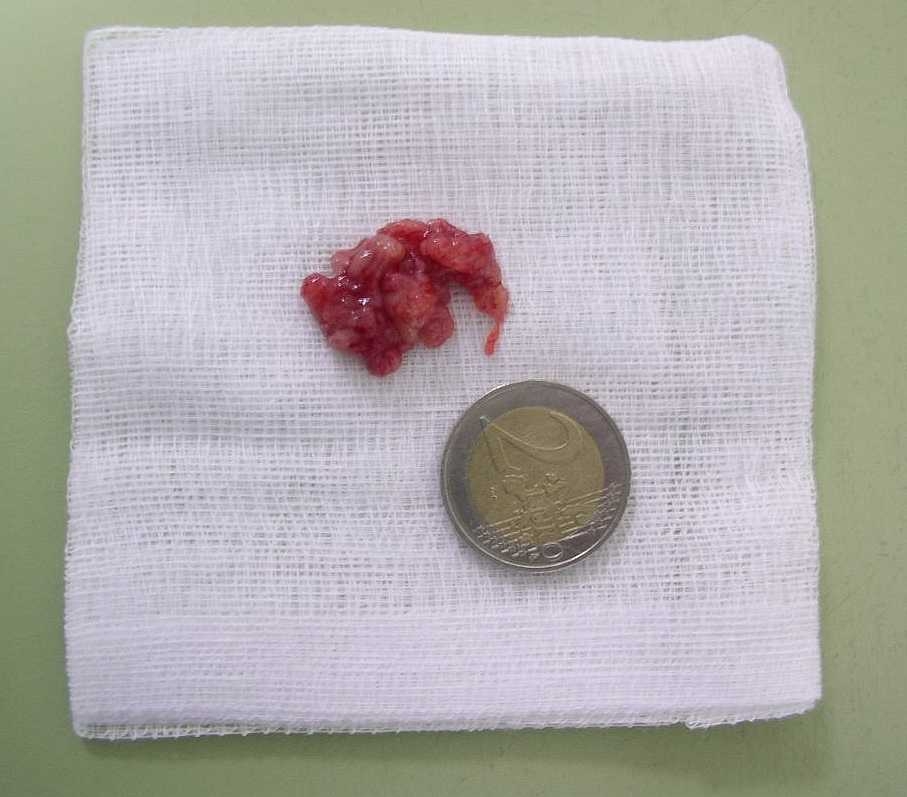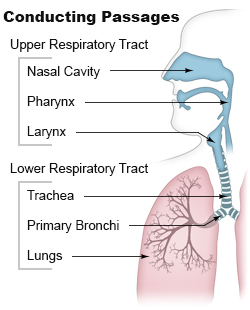|
Tonsillectomy
Tonsillectomy is a surgical procedure in which both palatine tonsils are fully removed from the back of the throat. The procedure is mainly performed for recurrent tonsillitis, throat infections and obstructive sleep apnea (OSA). For those with frequent throat infections, surgery results in 0.6 (95% confidence interval: 1.0 to 0.1) fewer sore throats in the following year, but there is no evidence of long term benefits. In children with OSA, it results in improved quality of life. While generally safe, complications may include bleeding, vomiting, dehydration, trouble eating, and trouble talking. Throat pain typically lasts about one to two weeks after surgery. Bleeding occurs in about 1% within the first day and another 2% after that. Between 1 in 2,360 and 1 in 56,000 procedures cause death. Tonsillectomy does not appear to affect long term immune function. Following the surgery, ibuprofen and paracetamol (acetaminophen) may be used to treat postoperative pain. The surge ... [...More Info...] [...Related Items...] OR: [Wikipedia] [Google] [Baidu] |
Adenoidectomy
Adenoidectomy is the surgical removal of the adenoid for reasons which include impaired breathing through the nose, chronic infections, or recurrent earaches. The effectiveness of removing the adenoids in children to improve recurrent nasal symptoms and/or nasal obstruction has not been well studied. The surgery is less commonly performed in adults in whom the adenoid is much smaller and less active than it is in children. It is most often done on an outpatient basis under general anesthesia. Post-operative pain is generally minimal and reduced by icy or cold foods. The procedure is often combined with tonsillectomy (this combination is usually called an "adenotonsillectomy" or "T&A"), for which the recovery time is an estimated 10–14 days, sometimes longer, mostly dependent on age. Adenoidectomy is not often performed under one year of age as adenoid function is part of the body's immune system, but its contribution to this decreases progressively beyond this age. Medical uses ... [...More Info...] [...Related Items...] OR: [Wikipedia] [Google] [Baidu] |
Obstructive Sleep Apnea
Obstructive sleep apnea (OSA) is the most common sleep-related breathing disorder and is characterized by recurrent episodes of complete or partial airway obstruction, obstruction of the respiratory tract#Upper respiratory tract, upper airway leading to reduced or absent breathing during sleep. These episodes are termed "apneas" with complete or near-complete cessation of breathing, or "hypopneas" when the reduction in breathing is partial. In either case, a fall in oxygen saturation (medicine), blood oxygen saturation, a disruption in sleep, or both, may result. A high frequency of apneas or hypopneas during sleep may interfere with the quality of sleep, whichin combination with disturbances in blood oxygenationis thought to contribute to negative consequences to health and quality of life. The terms obstructive sleep apnea syndrome (OSAS) or obstructive sleep apnea–hypopnea syndrome (OSAHS) may be used to refer to OSA when it is associated with symptoms during the daytime (e.g. ... [...More Info...] [...Related Items...] OR: [Wikipedia] [Google] [Baidu] |
Tonsillitis
Tonsillitis is inflammation of the tonsils in the upper part of the throat. It can be acute or chronic. Acute tonsillitis typically has a rapid onset. Symptoms may include sore throat, fever, enlargement of the tonsils, trouble swallowing, and enlarged lymph nodes around the neck. Complications include peritonsillar abscess, peritonsillar abscess (quinsy). Tonsillitis is most commonly caused by a viral infection and about 5% to 40% of cases are caused by a bacterial infection.Lang 2009p. 2083./ref> When caused by the bacterium group A streptococcus, it is classed as streptococcal tonsillitis also referred to as ''strep throat''. Rarely bacteria such as ''Neisseria gonorrhoeae'', ''Corynebacterium diphtheriae'', or ''Haemophilus influenzae'' may be the cause. Typically the infection is spread between people through the air. A scoring system, such as the Centor score, may help separate possible causes. Confirmation may be by a throat swab or rapid strep test. Treatment efforts in ... [...More Info...] [...Related Items...] OR: [Wikipedia] [Google] [Baidu] |
Palatine Tonsil
Palatine tonsils, commonly called the tonsils and occasionally called the faucial tonsils, are tonsils located on the left and right sides at the back of the throat in humans and other mammals, which can often be seen as flesh-colored, pinkish lumps. Tonsils only present as "white lumps" if they are inflamed or infected with symptoms of exudates (pus drainage) and severe swelling. Tonsillitis is an inflammation of the tonsils and will often, but not necessarily, cause a sore throat and fever. In chronic cases, tonsillectomy may be indicated. Structure The palatine tonsils are located in the isthmus of the fauces, between the palatoglossal arch and the palatopharyngeal arch of the soft palate. The palatine tonsil is one of the mucosa-associated lymphoid tissues (MALT), located at the entrance to the upper respiratory and gastrointestinal tracts to protect the body from the entry of exogenous material through mucosal sites. In consequence it is a site of, and potentia ... [...More Info...] [...Related Items...] OR: [Wikipedia] [Google] [Baidu] |
Guttate Psoriasis
Guttate psoriasis (also known as eruptive psoriasis) is a type of psoriasis that presents as small (0.5–1.5 cm in diameter) lesions over the upper trunk and proximal extremities; it is found frequently in young adults. The term " guttate" is used to describe the drop-like appearance of skin lesions. Guttate psoriasis is classically triggered by a bacterial infection, usually an upper respiratory tract infection. Signs and symptoms Typically, guttate psoriasis erupts after a throat infection, or strep throat. Initially, when the throat infection has cleared up, the person can feel fine for several weeks before noticing the appearance of red spots. They appear small at first, like a dry red spot which is slightly itchy. When scratched or picked, the top layer of dry skin is removed, leaving dry, red skin beneath with white, dry areas marking where flakes of dry skin stop and start. In the weeks that follow, the spots can grow to as much as an inch in diameter. Some of the ... [...More Info...] [...Related Items...] OR: [Wikipedia] [Google] [Baidu] |
Sleep Apnea
Sleep apnea (sleep apnoea or sleep apnœa in British English) is a sleep-related breathing disorder in which repetitive Apnea, pauses in breathing, periods of shallow breathing, or collapse of the upper airway during sleep results in poor ventilation and sleep disruption. Each pause in breathing can last for a few seconds to a few minutes and often occurs many times a night. A choking or snorting sound may occur as breathing resumes. Common symptoms include daytime sleepiness, snoring, and non restorative sleep despite adequate sleep time. Because the disorder disrupts normal sleep, those affected may experience sleepiness or feel tired during the day. It is often a chronic condition. Sleep apnea may be categorized as obstructive sleep apnea (OSA), in which breathing is interrupted by a blockage of air flow, central sleep apnea (CSA), in which regular unconscious breath simply stops, or a combination of the two. OSA is the most common form. OSA has four key contributors; these ... [...More Info...] [...Related Items...] OR: [Wikipedia] [Google] [Baidu] |
Surgical Instrument
A surgical instrument is a medical device for performing specific actions or carrying out desired effects during a surgery or operation, such as modifying biological tissue, or to provide access for viewing it. Over time, many different kinds of surgical instruments and tools have been invented. Some surgical instruments are designed for general use in all sorts of surgeries, while others are designed for only certain specialties or specific procedures. Classification of surgical instruments helps surgeons to understand the functions and purposes of the instruments. With the goal of optimizing surgical results and performing more difficult operations, more instruments continue to be invented in the modern era. History Many different kinds of surgical instruments and tools have been invented and some have been repurposed as medical knowledge and surgical practices have developed. As surgery practice diversified, some tools are advanced for higher accuracy and stability while so ... [...More Info...] [...Related Items...] OR: [Wikipedia] [Google] [Baidu] |
Periodic Fever, Aphthous Stomatitis, Pharyngitis And Adenitis
Periodic fever, aphthous stomatitis, pharyngitis and adenitis syndrome is a medical condition, typically occurring in young children, in which high fever occurs periodically at intervals of about 3–5 weeks, frequently accompanied by aphthous-like ulcers, pharyngitis and cervical adenitis (cervical lymphadenopathy). The syndrome was described in 1987 and named two years later. Signs and symptoms The key symptoms of PFAPA are those in its name: periodic high fever at intervals of about 3–5 weeks, as well as aphthous ulcers, pharyngitis and adenitis. In between episodes, and even during the episodes, the children appear healthy. At least 6 months of episodes. Cause The cause of PFAPA is unknown. It is frequently discussed together with other periodic fever syndromes. Possible causes include primarily genetic factors or it may be due to an initial infection. The condition appears to be the result of a disturbance of innate immunity. The changes in the immune system are complex ... [...More Info...] [...Related Items...] OR: [Wikipedia] [Google] [Baidu] |
List Of Surgical Procedures
Many surgical procedure names can be broken into parts to indicate the meaning. For example, in gastrectomy, "ectomy" is a suffix meaning the removal of a part of the body. "Gastro-" means stomach. Thus, ''gastrectomy'' refers to the surgical removal of the stomach (or sections thereof). "Otomy" means cutting into a part of the body; a ''gastrotonomy'' would be cutting into, but not necessarily removing, the stomach. In addition, "pharyngo" means pharynx, "laryngo" means larynx, "esophag" means esophagus. Thus, "pharyngolaryngoesophagectomy" refers to the surgical removal of the three. The field of minimally invasive surgery has spawned another set of words, such as ''arthroscopic'' or ''laparoscopic'' surgery. These take the same form as above; an arthroscope is a device which allows the inside of the joint to be seen. List of common surgery terms Prefixes * ''mono-'' : one, from the Greek μόνος, ', "only, single" * ''angio-'' : related to a blood vessel, from the Greek ... [...More Info...] [...Related Items...] OR: [Wikipedia] [Google] [Baidu] |
Airway Obstruction
Airway obstruction is a blockage of respiration in the airway that hinders the free flow of air. Airway obstructions can occur either in the upper airway or lower airway. The upper airway consists of the nose, throat, and larynx. The lower airway comprises the trachea, bronchi, and bronchioles. Airway obstruction is a life-threatening condition and requires urgent attention. Upper airway obstruction Causes The causes of upper airway obstructions can be acute or chronic. Acute causes of upper airway obstruction include foreign body aspiration, blunt trauma to the neck, infection, and swelling due to allergies or other inflammatory conditions. In children, viral infections such as croup or epiglottitis are frequent causes. Adults are more likely to experience obstruction from enlargement of the tonsils or vocal cord paralysis. Obstructive sleep apnea is the most common chronic cause of upper airway obstruction. Symptoms Stridor is a high-pitched sound which occurs d ... [...More Info...] [...Related Items...] OR: [Wikipedia] [Google] [Baidu] |
Tonsil Cancer
Oropharyngeal cancer, also known as oropharyngeal squamous cell carcinoma and tonsil cancer, is a disease in which abnormal cells with the potential to both grow locally and spread to other parts of the body are found in the oral cavity, in the tissue of the part of the throat (oropharynx) that includes the base of the tongue, the tonsils, the soft palate, and the walls of the pharynx. The two types of oropharyngeal cancers are HPV-positive oropharyngeal cancer, which is caused by an oral human papillomavirus infection; and HPV-negative oropharyngeal cancer, which is linked to use of alcohol, tobacco, or both. Oropharyngeal cancer is diagnosed by biopsy of observed abnormal tissue in the throat. Oropharyngeal cancer is staged according to the appearance of the abnormal cells on the biopsy coupled with the dimensions and the extent of the abnormal cells found. Treatment is with surgery, chemotherapy, or radiation therapy; or some combination of those treatments. Signs and sy ... [...More Info...] [...Related Items...] OR: [Wikipedia] [Google] [Baidu] |







